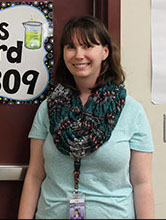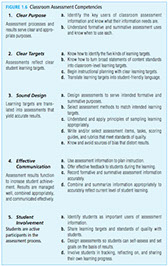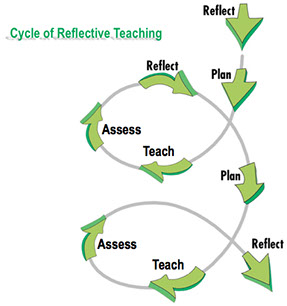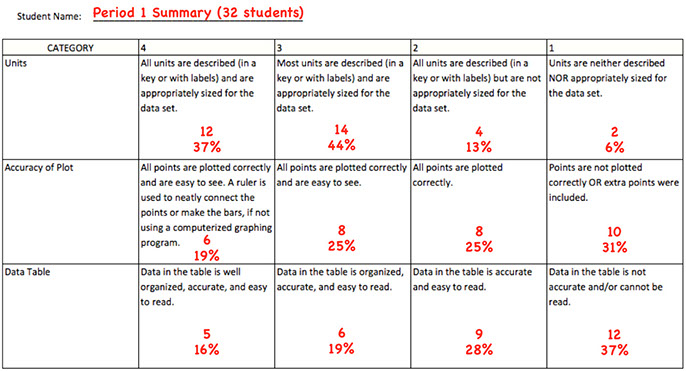Teaching Secondary Reading
A Resource for Improving Academic Literacy with Adolescents ©2015
Assessment in Backwards Design
Assessment at Achieve the Core

Teacher Cristina Huizar
Photo by Stephanie Estrada

Teacher Samuel Garcia
Photo by Stephanie Estrada

Teacher Aimee Savard
Photo by Stephanie Estrada
Assessment
Assessment is the tool by which teachers hold themselves and their students accountable to meet their learning objectives. The purpose of assessment is to diagnose student learning needs and to evaluate the effectiveness of your instruction.
According to Chappuis, Stiggins, Chappuis & Arter (2012), "all of the pieces contributing to sound classroom assessment...are built on a foundation of the following five keys to quality:
1. They are designed to serve the specific information needs of intended user(s).
2. They are based on clearly articulated and appropriate achievement targets.
3. They accurately measure student achievement.
4. They yield results that are effectively communicated to their intended users.
5. They involve students in self-assessment, goal setting, tracking, reflecting on, and sharing their learning.
This page refers to Chapter 1 from Chappuis, Stiggins et al. (2012) as a framework for developing effective classroom assessment. Click on the chart to the right for a summary of the teacher competencies implied by their five keys.
Click on the chart to the right for a summary of the teacher competencies implied by their five keys.
An effective classroom assessment practice involves many parts (Chappuis, Stiggins et al., 2012, p. 3), such as:
- Planning and managing both formative and summative assessments in the classroom
- Identifying, clarifying, and teaching to valued learning targets
- Designing or selecting high-quality assessment items and tasks
- Devising high-quality scoring keys, guides, and rubrics
- Using assessment results to plan further instruction
- Offering descriptive feedback during learning
- Designing assessments so that students can self-assess and set goals
- Tracking student achievement along with other relevant data
- Setting up a system so students can track and share their progress
- Calculating grades that accurately represent student achievement at the time they are assigned

We use assessment of student work to inform the cycle of reflective teaching. Through reflection, we analyze the formative and summative assessments we've designed and use what we've learned about student performance to plan our next steps in teaching and assign marks to students.
Formative Assessments are ways that teachers gather evidence for the purpose of improving learning.
Summative Assessments provide evidence of student achievement in order to evaluate a student's competence or the effectiveness of a program.
The purpose of the classroom assessment is inform the teacher how successfully her learning objective has been met by all students.
Rubrics can be a helpful tool in making that determination. Look back at the TSR Performance Task rubric. There are 5 criteria for evaluation. The fifth criteria, "Planning: Designing Assessments" focuses on the planning phase of student assessment. The rubric asks how the teacher provided opportunities for students to demonstrate the understanding of the learning objectives. The reflection phase of student assessment asks the teacher to collect student work samples and analyze them as data.
The Performance Assessment for California Teachers (PACT), asks teacher candidates to:
1) Select an assessment tool and criteria that are aligned with your central focus, student standards, and learning objectives;
2) Analyze student performance on an assessment in relation to student needs and the identified learning objectives;
3) Provide feedback to students; and
4) Use the analysis to identify next steps in instruction for the whole class and individual students.
For #1, use the backward design approach to align learning activities with student outcomes.
For #2, summarize student learning by tallying student scores on your rubric, as below. Who was successful, and who was not? Rubrics with student scores tallied provide the evidence used to answer those questions.

For #3, see this guide to Effective Instructional Feedback from Scarcella (2003). Consider how you are leading students in their development, as well as what you can learn about your own teaching.
For #4, develop your skill in interpreting your findings. To what do you attribute these outcomes?
Sample questions using the summary of student scores above:
- On which criteria (Units, Accuracy of Plot, or Data Table) were students most successful? Least successful? The "cut point" for the rubric above is a "3," meaning a student must score a "3" in order to be considered successful.
- If there are big differences in success levels between criteria, what might explain those differences?
- As you examine the individuals and groups of students that fall into each category, do you notice any patterns? What knowledge or skill gaps seem to be revealed in your examination?
- What does the pattern of scores suggest about your instruction? Were the activities engaging and well-run? Were the directions clear? Do students know what they had to do in order to be successful?
- Based on your analysis, what should your next steps in instruction be? How will address individual and sub-group needs?
The views and opinions expressed on unofficial pages of California State University, Dominguez Hills faculty, staff or students are strictly those of the page authors.
The content of these pages has not been reviewed or approved by California State University, Dominguez Hills.